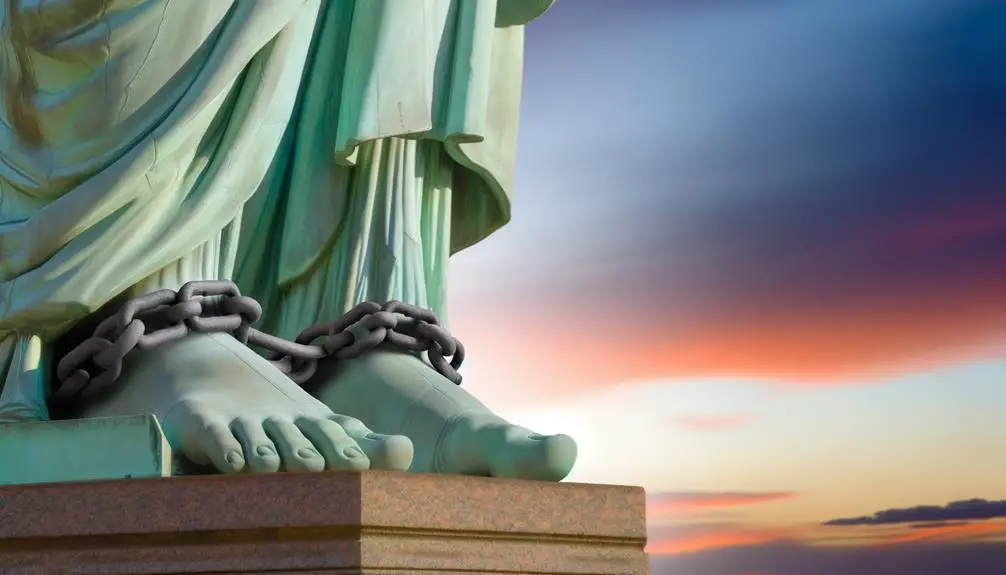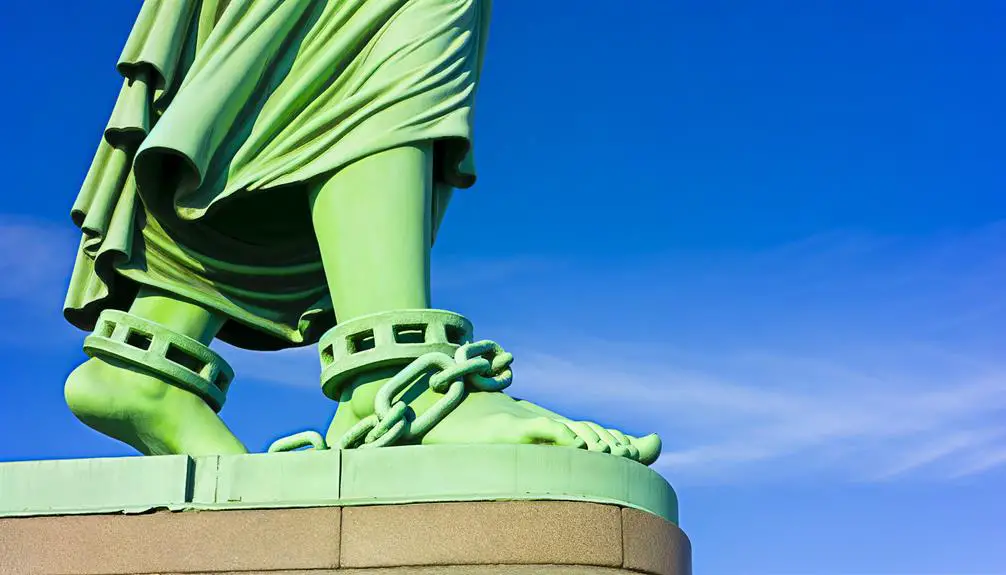Understanding the Symbolism and Meaning of the Statue of Liberty
The Statue of Liberty, a monumental gift from France in 1886, symbolizes freedom, enlightenment, and the deep-rooted Franco-American alliance. Its torch represents hope and knowledge, guiding towards freedom, while the seven spikes of its crown stand for universal liberty.
The inscribed tablet carries the date of American independence, reminding us of foundational values. Broken chains at its feet symbolize the end of oppression and the triumph of human rights.
The classical robe links modern liberty to ancient traditions. Each detail invokes themes of emancipation, global ideals, and the enduring struggle for human rights, inviting further exploration into its rich symbolism.

Key Takeaways
- The torch symbolizes hope, enlightenment, and the ongoing struggle for human rights.
- The crown's seven spikes represent universal liberty across all continents and seas.
- The tablet inscribed with the date of American independence signifies foundational principles and collective wisdom.
- Broken chains at the statue's feet reflect emancipation, liberation from tyranny, and the fight for civil rights.
- The classical robe symbolizes timeless freedom, justice, and the enduring nature of liberty.
Historical Background

The Statue of Liberty, a massive neoclassical sculpture on Liberty Island in New York Harbor, was a gift from France to the United States in 1886, symbolizing the enduring friendship between the two nations and their shared values of liberty and democracy.
Designed by Frédéric Auguste Bartholdi and engineered by Gustave Eiffel, the statue commemorates the centennial of the American Declaration of Independence. Its construction was funded by both French and American citizens, reflecting a transatlantic partnership.
The statue's revealing coincided with a period of significant immigration to the United States, further embedding it as a symbol of hope and freedom. This historical context underscores its role as an emblematic figure in the narrative of American identity and international solidarity.
The Torch
Illuminating the world, the torch of the Statue of Liberty serves as a powerful beacon symbolizing enlightenment, guidance, and the enduring quest for freedom and democracy. This iconic element carries profound significance, reflecting the values upon which the statue was conceived. The torch's light represents:
- Hope: Inspiring those who seek a better life.
- Knowledge: Enlightening minds to the principles of liberty.
- Guidance: Directing individuals towards freedom.
- Unity: Bridging diverse cultures under shared ideals.
- Perseverance: Reminding all of the ongoing struggle for human rights.
These interpretations underscore the torch's role as not merely a physical attribute but a multifaceted emblem of aspiration and progress, reinforcing the universal message of the Statue of Liberty.
The Crown

Crowning the Statue of Liberty, the seven spikes of the crown represent the seven continents and seven seas, symbolizing universal liberty and the global reach of freedom. This design choice underscores the statue's role as a beacon of hope and a universal emblem of human rights.
The crown's elevated position on Lady Liberty's head further signifies enlightenment and the light of knowledge. Historically, the crown's spikes were also intended to evoke the radiance of the sun, resonating with the Enlightenment ideals that inspired the statue's creation.
Architecturally, the crown serves a dual purpose: it is both an aesthetic feature and a functional observation deck, allowing visitors to experience panoramic views, thereby physically embodying the statue's message of openness and perspective.
The Tablet
The tablet held by the Statue of Liberty is inscribed with the date of American independence, 'July 4, 1776,' serving as a powerful reminder of the nation's founding principles.
This inscription underscores the statue's role not just as a beacon of freedom, but also as a symbol of the knowledge and enlightenment that informed the creation of the United States.
Inscription of Independence Date
Central to the Statue of Liberty's symbolism, the tablet she holds is inscribed with the date of American independence, July 4, 1776, in Roman numerals. This inscription, 'JULY IV MDCCLXXVI,' underscores the monument's dedication to the principles of liberty and freedom. The choice of Roman numerals adds a classical touch, evoking the democratic ideals of ancient Rome, which influenced the founding fathers.
- Historical Significance: Commemorates the adoption of the Declaration of Independence.
- Symbolic Weight: Emphasizes the nation's birth and enduring values.
- Design Choice: Roman numerals connect modern America with its philosophical roots.
- Educational Aspect: Encourages reflection on the historical context.
- Cultural Resonance: Enhances the monument's role as an icon of freedom globally.
This inscription is a constant reminder of America's foundational ethos.
Symbol of Knowledge
Beyond marking the date of American independence, the tablet also serves as a symbol of knowledge, representing enlightenment and the importance of education in maintaining a free society.
The inscribed date, July 4, 1776, is not merely a historical marker but a reminder of the intellectual foundations that underpin democratic governance. It emphasizes that an informed citizenry is essential for the preservation of liberty and justice.
The tablet, held firmly in Lady Liberty's left hand, signifies the collective wisdom and enduring principles enshrined in the Declaration of Independence. This symbolism underscores the role of education in empowering individuals to contribute meaningfully to society, fostering an environment where freedom and knowledge coexist harmoniously.
Broken Chains

The broken chains at the feet of the Statue of Liberty symbolize emancipation and the triumph over oppression. Embedded within the broader historical context of the abolition of slavery and the fight for human rights, these chains underscore the statue's role as a beacon of freedom.
Their inclusion not only highlights a critical aspect of American history but also conveys the universal aspiration for liberty and justice.
Emancipation and Freedom Representation
How does the imagery of the broken chains at the feet of the Statue of Liberty encapsulate the profound ideals of emancipation and freedom?
The broken chains, often overlooked, are a powerful symbol of liberation from oppression and tyranny. These chains are not merely ornamental; they convey a deeper narrative of humanity's continuous struggle for freedom.
The significance of this imagery can be understood through several key aspects:
- Symbol of Liberation: Represents the end of enslavement and the beginning of freedom.
- Historical Relevance: Reflects the abolition of slavery and the Civil War's aftermath.
- Universal Appeal: Resonates with global struggles for human rights.
- Legal and Social Progress: Embodies the advancements in civil liberties.
- Inspiration: Encourages ongoing efforts towards equality and justice.
This symbolism reinforces the universal principles of liberty and human dignity.
Historical Context and Significance
Understanding the historical context of the broken chains at the feet of the Statue of Liberty is vital to appreciating their full symbolic significance. These chains, often overlooked, are essential in representing the abolition of slavery and the broader struggles for freedom and justice.
Conceived in the aftermath of the American Civil War and during a period of profound social change, the broken chains reflect the nation's journey towards emancipation. The sculptor, Frédéric Auguste Bartholdi, intentionally used this imagery to underscore liberty's triumph over oppression.
Situated at Lady Liberty's feet, they symbolize the shackles of tyranny being cast off, an enduring evidence to the ideals of freedom and the ongoing quest for equality. This historical context enriches our understanding of the statue's deeper meanings.
Seven Rays
Representing the seven continents and seven seas, the seven rays on the Statue of Liberty's crown serve as a powerful symbol of universal liberty and enlightenment. These rays extend outward, signifying the reach of freedom across the globe. Their design is not merely decorative but imbued with profound meaning, reflecting the universality of liberty principles.
This symbolism can be analyzed through several lenses:
- Historical context: designed during a period of global exploration and colonial expansion.
- Artistic influence: inspired by classical depictions of sun gods and goddesses.
- Engineering marvel: constructed to withstand natural elements.
- Cultural resonance: embodying ideals of the Enlightenment and democratic values.
- Global significance: recognized as a beacon of hope for immigrants and oppressed peoples worldwide.
Understanding these elements enriches our appreciation for this iconic monument.
The Pedestal

Anchoring the Statue of Liberty, the pedestal serves not only as a structural foundation but also as a profound symbol of the robust support necessary for the ideals of freedom and democracy. Designed by architect Richard Morris Hunt, the pedestal stands at 89 feet, composed of concrete and granite. It is an architectural marvel that contextualizes the immense weight and significance of Lady Liberty herself.
The pedestal's design integrates elements of classical architecture, echoing ancient civilizations that similarly valued liberty and justice. In addition, it houses the museum that educates visitors about the statue's history and symbolism. This dual role of physical support and educational resource underscores the importance of a solid foundation, both literally and metaphorically, in upholding democratic ideals.
The Robe
The robe of the Statue of Liberty is historically inspired by the classical drapery of ancient Roman goddesses, symbolizing a timeless connection to the ideals of liberty and justice.
This stylistic choice underscores the enduring nature of freedom, which transcends historical epochs and cultural boundaries.
Historical Inspiration Behind Robe
Drawing inspiration from ancient Roman iconography, the Statue of Liberty's robe symbolizes both the classical ideals of liberty and the enduring influence of classical antiquity on modern democratic principles. The robe, reminiscent of the garments worn by Roman goddesses, carries a wealth of historical significance that connects the past with contemporary values.
Key aspects include:
- Classical Aesthetics: Emulating the draped garments of Roman figures, it evokes an era of philosophical and political innovation.
- Symbolism of Authority: Robes in Roman culture often denoted status and power.
- Cultural Resonance: The design bridges Western historical traditions with the ideals of the American Republic.
- Timelessness: The classical style underscores the timeless nature of liberty.
- Artistic Influence: Reflects the 19th-century neoclassical artistic movement prominent during the statue's creation.
Symbolic Representation of Freedom
In its flowing drapery, the Statue of Liberty's robe embodies the essence of freedom, representing an unbounded spirit and the liberation from oppression. The robe's design, reminiscent of classical Greco-Roman attire, signifies the timeless nature of liberty and democracy. The layers of fabric suggest a journey from darkness to enlightenment, encapsulating the struggles and triumphs of those who seek freedom.
| Aspect | Symbolism | Interpretation |
|---|---|---|
| Drapery Style | Classical Antiquity | Timelessness of Liberty |
| Flowing Fabric | Unbounded Spirit | Liberation from Oppression |
| Layered Design | Journey from Darkness | Struggles and Triumphs |
| Overall Appearance | Grace and Strength | Enduring Nature of Democracy |
The robe is not just a garment but a powerful symbol, intertwining historical significance with contemporary ideals of freedom.
The Feet

Symbolically anchored in freedom, the feet of the Statue of Liberty are depicted breaking free from the chains of oppression and tyranny. This imagery is rich with meaning, underscoring the statue's embodiment of liberation and forward progression.
The broken shackles and chains represent:
- End of Enslavement: A definitive break from the historical context of slavery.
- Overcoming Tyranny: Liberation from authoritarian rule.
- Freedom of Movement: Signifying the freedom to pursue one's own path.
- Hope and Renewal: Emphasizing a new beginning with each step forward.
- Universal Emancipation: Advocating for global liberation from oppressive forces.
These elements collectively amplify the statue's role as a beacon of hope and a symbol of emancipatory ideals, resonating deeply within the broader narrative of human rights.
The Colossal Scale
Standing at a towering height of 305 feet from the ground to the tip of the torch, the Statue of Liberty's colossal scale is a deliberate design choice that underscores its monumental significance as a symbol of freedom and democracy. This immense size not only makes it an imposing landmark visible from great distances but also conveys the vastness of the ideals it represents.
Designed by Frédéric Auguste Bartholdi, the statue's large scale was intended to evoke awe and respect, thereby reinforcing the profound message of liberty and enlightenment. The sheer magnitude of the statue ensures that its presence is felt both physically and symbolically, serving as a constant reminder of the enduring principles upon which the United States was founded.
Conclusion
The Statue of Liberty, with its torch, crown, tablet, broken chains, pedestal, robe, and colossal scale, embodies a rich tapestry of symbolic meanings that extend beyond mere aesthetics. Each element is meticulously crafted to convey ideals of freedom, democracy, and enlightenment.
However, the true depth of its symbolism reveals itself only when one contemplates the intricate historical and cultural contexts from which it emerged. What further layers of meaning might still be uncovered about this iconic monument?






